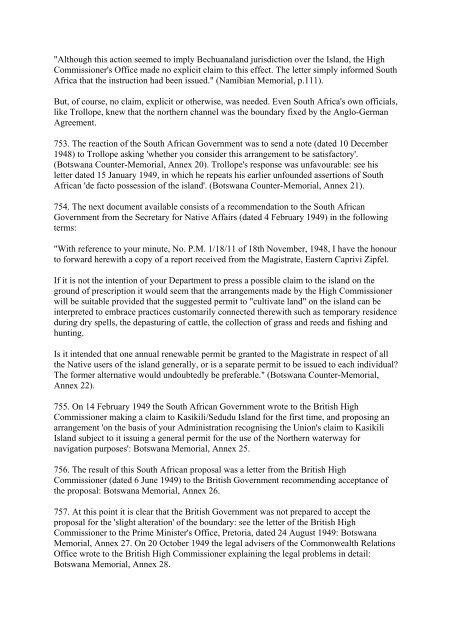botswana/namibia - Cour international de Justice
botswana/namibia - Cour international de Justice
botswana/namibia - Cour international de Justice
Create successful ePaper yourself
Turn your PDF publications into a flip-book with our unique Google optimized e-Paper software.
"Although this action seemed to imply Bechuanaland jurisdiction over the Island, the High<br />
Commissioner's Office ma<strong>de</strong> no explicit claim to this effect. The letter simply informed South<br />
Africa that the instruction had been issued." (Namibian Memorial, p.111).<br />
But, of course, no claim, explicit or otherwise, was nee<strong>de</strong>d. Even South Africa's own officials,<br />
like Trollope, knew that the northern channel was the boundary fixed by the Anglo-German<br />
Agreement.<br />
753. The reaction of the South African Government was to send a note (dated 10 December<br />
1948) to Trollope asking 'whether you consi<strong>de</strong>r this arrangement to be satisfactory'.<br />
(Botswana Counter-Memorial, Annex 20). Trollope's response was unfavourable: see his<br />
letter dated 15 January 1949, in which he repeats his earlier unfoun<strong>de</strong>d assertions of South<br />
African '<strong>de</strong> facto possession of the island'. (Botswana Counter-Memorial, Annex 21).<br />
754. The next document available consists of a recommendation to the South African<br />
Government from the Secretary for Native Affairs (dated 4 February 1949) in the following<br />
terms:<br />
"With reference to your minute, No. P.M. 1/18/11 of 18th November, 1948, I have the honour<br />
to forward herewith a copy of a report received from the Magistrate, Eastern Caprivi Zipfel.<br />
If it is not the intention of your Department to press a possible claim to the island on the<br />
ground of prescription it would seem that the arrangements ma<strong>de</strong> by the High Commissioner<br />
will be suitable provi<strong>de</strong>d that the suggested permit to "cultivate land" on the island can be<br />
interpreted to embrace practices customarily connected therewith such as temporary resi<strong>de</strong>nce<br />
during dry spells, the <strong>de</strong>pasturing of cattle, the collection of grass and reeds and fishing and<br />
hunting.<br />
Is it inten<strong>de</strong>d that one annual renewable permit be granted to the Magistrate in respect of all<br />
the Native users of the island generally, or is a separate permit to be issued to each individual?<br />
The former alternative would undoubtedly be preferable." (Botswana Counter-Memorial,<br />
Annex 22).<br />
755. On 14 February 1949 the South African Government wrote to the British High<br />
Commissioner making a claim to Kasikili/Sedudu Island for the first time, and proposing an<br />
arrangement 'on the basis of your Administration recognising the Union's claim to Kasikili<br />
Island subject to it issuing a general permit for the use of the Northern waterway for<br />
navigation purposes': Botswana Memorial, Annex 25.<br />
756. The result of this South African proposal was a letter from the British High<br />
Commissioner (dated 6 June 1949) to the British Government recommending acceptance of<br />
the proposal: Botswana Memorial, Annex 26.<br />
757. At this point it is clear that the British Government was not prepared to accept the<br />
proposal for the 'slight alteration' of the boundary: see the letter of the British High<br />
Commissioner to the Prime Minister's Office, Pretoria, dated 24 August 1949: Botswana<br />
Memorial, Annex 27. On 20 October 1949 the legal advisers of the Commonwealth Relations<br />
Office wrote to the British High Commissioner explaining the legal problems in <strong>de</strong>tail:<br />
Botswana Memorial, Annex 28.

















